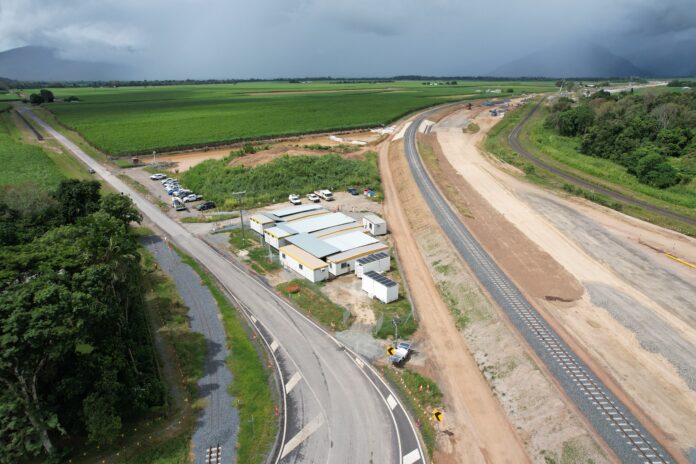The extensive use of plant equipment in construction poses challenges to emissions reduction, demanding creative approaches in equipment selection and construction methodology. The Bruce Highway, Cairns Southern Access Corridor (Stage 3), Edmonton to Gordonvale (E2G) project has tackled this challenge by the development and deployment of six solar hybrid systems to replace traditional generators across the project, a first for the state of Queensland, Australia. This setup has led to a 75% reduction in diesel usage and greenhouse gas emissions compared to the use of traditional generators resulting in a substantial cost saving for the project as well as other additional sustainability benefits.
Project Description
The Bruce Highway, Cairns Southern Access Corridor, (Stage 3) Edmonton to Gordonvale Project (E2G) is a road and rail project just south of Cairns in far-north Queensland. Located in a rural area, most of the site is located within former agricultural land and
is spread over a 10.5 km- (6.5 mile-) long and 3.5 km- (2 mile-) wide footprint. The project is a design and construction project with the primary scope involving the duplication of a 10.5 km (6.5 mile) section of the Bruce Highway to create a four-lane highway from Edmonton to Gordonvale. Additional works include the realignment and upgrade of 4.7 km (3 miles) of railway, installation of 11 bridges, construction of a 10km (6 mile) footpath and upgrades of utilities including water, sewer, overhead and underground power and communications.
Drivers
The large footprint of the project required the deployment of multiple remote compounds to provide efficient crib facilities and shelter to the workforce close to the various work sites across the project during the construction phase. Due to the remote location of these compounds, a grid connection was impractical to provide power and the business-as-usual approach of hooking up a large diesel generator to power each site was originally planned.
The project’s environment and sustainability team saw this as an opportunity to utilise solar off-grid as an alternative for powering these remote compounds while supporting the sustainability targets of the project. The business-as-usual generators operated constantly to provide power to the site compounds, and it was proposed that by deploying a solar hybrid system the project would be able to reduce generator runtime, thereby reducing total carbon emissions and diesel burned.
A feasibility study was carried out to determine the exact power requirements of each compound and calculate both the running costs and total costs of using a generator for the life of the project.

State of the Market
A review was undertaken into procuring a solar hybrid system, however, what was available on the market in 2021 had the following issues:
- Undersized for the load required by a construction compound with no scalability.
- Only provided single phase power.
- Ground mount photovoltaic (PV) arrays required skilled labour, materials (such as concrete for footings) and plant to construct.
- Systems were ad hoc combinations of separate components requiring specialists to be onboarded to deploy.
- Unable to be easily relocated.
- Required a significant footprint due to large ground mount PV arrays.
- Required working at heights and high-risk work permits for installation.
- Significant cost and lead time.
- No power redundancy in the event of a system failure.
- Not secure to tampering or severe weather.
This analysis resulted in a design brief for a custom system. Four suppliers were shortlisted from the initial review and were provided with the following requirements:
- 100% relocatable.
- Provide 3-phase power.
- Fitted in a standard container for security, easy transport, minimal footprint and weather protection.
- Wiring process similar to a traditional generator setup.
- Operatable by project staff.
- Sized to service the off-peak and overnight load completely on PV or battery, with a generator to assist in short peak loads (mealtimes) and/or charge batteries when required.
- Complete power redundancy.
- Provide reliable 24-hour power to each site compound.
- Safe deployment requiring no working at heights, excavations or high-risk works permits.
- Cost benefit for the project.
- Modular and scalable for future projects (both larger and smaller).
- Easily replicable with the ability to deploy multiple systems in a reasonable time frame.
Designing a Solution
Based on the outcome of the feasibility study and associated cost-benefit analysis, the project made the decision to purchase the NQ Solar designed Containerised Solar-Hybrid system.
The system uses roof-mounted solar to provide power to a battery bank secured within the container (Figure 1). This battery provides 24-hour 3-phase power to the compound. A backup generator sized to service the potential maximum load provides redundancy to the system while also providing a method to charge the batteries if the PV is insufficient. Because the batteries are the most expensive component of the system, they were only sized to handle the overnight load until the PV kicks in the next morning. This maximizes the cost/benefit of the system because larger, more expensive batteries would provide no benefit to the system. The second container can be used for secure project storage while also providing additional PV generation. Additional PV containers can be added to scale up the system and the internal components (battery capacity and inverters) can be scaled up or down in the future depending on project requirements (Figure 2).
The supplier further developed these systems into a smaller scale trailer mounted version (Figure 3).
Project Outcomes
The first system was deployed in early September 2021, with a total of six systems deployed on the project between 2021 and 2023. The following immediate benefits were observed on site:
- The containerised systems powering the compounds observed the following benefits: over 75% reduction in diesel usage and associated greenhouse gas (GHG) emissions, saving approximately 10,000 L (2,600 gallons) of diesel per year per unit, and providing 24-hour reliable power. This reduction created a cost saving for the project, with each system achieving a net break-even point of around 18 months and cost savings beyond that point.
- Additional benefits include security lights (crime prevention), the ability to use fridges, septic system and amenities overnight and allowing the workforce access to hot water for hygiene, hot drinks and ice machines at the start of the workday. Traditionally these services are not available to the workforce until later in the day as the water heaters and ice machines take time to start up once the generator is turned on. This was key due to the tropical climate increasing heat risks.
- The trailer-mounted relocatable solar hybrid systems providing temporary power to utilities observed the following benefits: over 80% reduction in diesel usage and associated cost and GHG emissions, saving approximately 9,000 L (2,400 gallons) of diesel per year per unit, and reduction in runtime to less than two hours every other night, significantly reducing noise impacts on nearby sensitive receivers.

Lessons Learned
The following lessons have been learned during the deployment of these systems onsite and should be considered when installing similar systems on future projects.
- Any planned changes to the load (planned increasing size of compound for example) needs to be considered in the component sizing to ensure the power draw can be met.
- Deploy systems as early as possible to maximise diesel reduction and cost savings. This should be included in the design brief for any remote compound to allow for more efficiency in design (e.g. solar included on roof while compounds being constructed vs. later work at heights risk).
- Ensure buy-in from project management and the construction team to secure footprint at deployment location and resources.
- Investigate opportunities for onsite energy efficiencies using timers and sizing of electronic equipment and the highest wattage panels as possible.
- Develop an easily understood troubleshooting cheat sheet and nominate appropriate members of the workforce to be upskilled in the operation of the systems to ensure that any onsite issues (e.g. power failures requiring restart) can be quickly resolved by the site team.
Conclusions
Deployment of these systems is a step towards renewable/carbon neutral remote energy being deployed in the infrastructure construction industry. The project has proven that off-grid solar is a feasible and cost-effective replacement to traditional generator power with both a significant reduction in diesel usage and a proven cost saving. These systems are designed to be a direct plug and play replacement to a traditional generator setup and can be deployed and installed in the same manner with a minimal footprint.
About the Expert
Andrew Kindness, CPESC, is a skilled sustainability and environmental advisor with a strong background in environmental sustainability and diverse experience in infrastructure construction. Most recently, he leads the sustainability outcomes for the E2G Project in Cairns, Queensland, Australia while also supporting the team in managing erosion and sediment control.












